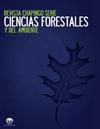尤卡坦半岛雪松目前和未来的潜在分布和适宜保护区的确定
IF 0.5
4区 农林科学
Q3 Agricultural and Biological Sciences
Revista Chapingo Serie Ciencias Forestales Y Del Ambiente
Pub Date : 2020-08-30
DOI:10.5154/r.rchscfa.2019.10.075
引用次数: 4
摘要
简介:红雪松(Cedrela odorata L.)因其木材而备受赞赏,这种情况导致森林管理不善,因此其分布面积减少。目的:在尤卡坦半岛确定气味C.odorata的当前和未来潜在分布,并确定适合保护该物种的种子产地。材料和方法:从全球生物多样性信息基金(GBIF)、国家森林和土壤清单(INFyS,西班牙语)和《墨西哥热带Arboles tropicales de Mexico》一书中获得了气味C.odorata的存在记录。该模型是在MaxEnt中使用当前环境变量和未来(2030年)气候变化情景以1平方公里的空间分辨率进行的。75%的记录用于训练模型,25%用于验证模型。贡献最大的变量是通过jackknife测试确定的。结果和讨论:估计的气味C.odorata的当前潜力分布为404917公顷。气候变化模拟预测,合适的栖息地将减少(31%至44.8%),卡拉克穆尔、洛斯·彼得内斯和里亚·塞莱斯图恩的自然保护区将作为气候避难所,保护约76472公顷的土地。分布中的重要变量是:植被(34.7%)、最潮湿月份的降水量(14.6%)、土壤学(8.8%)、最寒冷地区的平均温度(8.6%)和坡度(7%)。结论:该模型可以确定具有气味C.odorata生境质量的适宜区域。鉴于气候变化的威胁,在ANP中分布C.odorata将有助于就地保护和恢复计划。本文章由计算机程序翻译,如有差异,请以英文原文为准。
Current and future potential distribution and identification of suitable areas for the conservation of Cedrela odorata L. in the Yucatan Peninsula
Introduction: Red cedar (Cedrela odorata L.) is appreciated for its wood, a situation that has caused poor
forest management and, therefore, a decrease in its areas of distribution.
Objective: To delimit the current and future potential distribution of C. odorata and to identify suitable
seed-producing areas for the conservation of the species in the Yucatan Peninsula.
Materials and methods: Records of the presence of C. odorata were obtained from the Global Biodiversity
Information Facility (GBIF), the National Forest and Soil Inventory (INFyS in Spanish) and the book “Arboles
tropicales de Mexico”. The modeling was done in MaxEnt using current environmental variables and future
(2030) climate change scenarios at 1 km2 spatial resolution. Seventy-five percent of the records were used
to train the models and 25 percent to validate them. The variables with the greatest contribution were
determined by the jackknife test.
Results and discussion: The estimated current potential distribution of C. odorata was 404917 ha. Climate
change simulations predict a reduction (31 to 44.8 %) of the suitable habitat, where the natural protected
areas (ANPs) of Calakmul, Los Petenes and Ria Celestun would serve as climate refuges, conserving about
76472 ha. The important variables in the distribution were: vegetation (34.7 %), precipitation of the wettest
month (14.6 %), edaphology (8.8 %), average temperature of the coldest quarter (8.6 %) and slope (7 %).
Conclusion: The models allowed the identification of suitable areas with habitat quality of C. odorata. In
view of the threats of climate change, the distribution of C. odorata in ANPs would help conservation and
restoration programs in situ.
求助全文
通过发布文献求助,成功后即可免费获取论文全文。
去求助
来源期刊
CiteScore
1.20
自引率
16.70%
发文量
0
审稿时长
>12 weeks
期刊介绍:
The Revista Chapingo Serie Ciencias Forestales y del Ambiente (RCHSCFA) is a scientific journal that aims to raise awareness of high-quality research products related to forest, arid, temperate and tropical environments in the world. Since its foundation in 1994, the RCHSCFA has served as a space for scientific dissemination and discussion at a national and international level among academics, researchers, undergraduate and graduate students, forest managers and public/private entities that are interested in the forest environment.
All content published in the journal first goes through a strict triple-blind review process and is published in the following formats: Scientific Articles, Review Articles, Methodologies, Technical or Technological Notes.

 求助内容:
求助内容: 应助结果提醒方式:
应助结果提醒方式:


